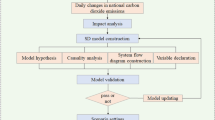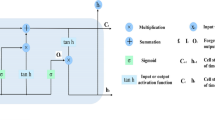Abstract
Along with the rapid economic development of China, carbon dioxide (CO\(_{2}\)) emissions will inevitable rise in the future. This will happen even though the Chinese government has made a series of attempts to constrain the CO\(_{2}\)-emissions, and is committed to reduce its CO\(_{2}\)-emissions per unit of gross domestic product (GDP) by 40–45 % (1,045–1,140 tons/million dollars) by 2020 from 2005 levels. However, according to estimates the total amount of CO\(_{2}\)-emissions will grow to more than 13 billion tons, and the carbon intensity will be twice of the world average. In order to improve this situation, this research study will construct a comprehensive dynamic simulation model to forecast China’s CO\(_{2}\)-emissions and GDP development under different energy structure adjustment plans and carbon intensity constraints from 2008 to 2020. In addition, find out the trade-off between Chinese carbon intensity reduction and economic development. The comprehensive model we constructed includes a CO\(_{2}\)-emissions model, an energy balance model, and a socio-economic model. Through a dynamic simulation analysis established by LINGO programming, this study provides the proper carbon intensity that China can achieve under the current situation, lie 1,040 tons/million dollars in 2020 (a 45 % reduction compared with the situation in 2005), while the CO\(_{2}\)-emissions will be 12.51 billion tons, the proportion of non-fossil energy 15 %, and the average annual increase in GDP 9 %. This research provides an effective method to estimate the interaction between economic growth and CO\(_{2}\)-emissions reduction, with alternative energy utilization in the future.






Similar content being viewed by others
References
Ang, B.W., Zhang, F.Q.: A survey of index decomposition analysis in energy and environmental studies. Energy 25, 1149–1176 (2000)
China Statistics Bureau: China Year book (2008). China Statistics Press, Beijing (2008)
Department of Energy Statistics, National Bureau of Statistics, China.: China Energy Statistical Year Book (2008). China Statistics Press, Beijing (2008)
Gregg, J., Andres, R., Marland, G.: China: emissions pattern of the world leader in CO\(_{2}\)emissions from fossil fuel consumption and cement production. Geophys. Res. Lett. 35, L8806 (2008)
Higano, Y., Nijkamp, P., Poot, J.: The Region in the New Economy: An International Perspective on Regional Dynamics in the 21st Century. Ashgate Pub Ltd, London (2002)
Hof, A., den Elzen, M.G.J., van Vuuren, D.P.: Environmental effectiveness and economic consequences of fragmented vs. universal regimes: what can we learn from model studies. Int. Environ. Agreem. Polit. Law Econ. 9(1), 39–62 (2009)
IEA: Key World Energy Statistics 2007, International Energy Agency, Paris (2007)
Lenzen, M.: Aggregation versus disaggregation in input–output analysis of the environment. Econ. Syst. Res. 23, 73–89 (2011)
Leontief, W.: Environmental repercussions and the economic structure: an input–output approach. Rev. Econ. Stat. 52, 262–271 (1970)
Li, B., Higano, Y.: An environmental socioeconomic framework model for adapting to climate change in China. Adv. Spatial Sci. C, 327–349 (2007)
Lin, B.Q., Sun, C.W.: Evaluating carbon dioxide emissions in international trade of China. Energy Policy 38(1), 613–621 (2010)
Machado, G., Schaeffer, R., Worrell, E.: Energy and carbon embodied in the international trade of Brazil: an input–output approach. Ecolog. Econ. 39, 409–424 (2001)
Morrison, W. M. : China’s economic conditions. CRS Report RL33534. (2008)
Netherlands Environmental Assessment Agency (PBL): Global CO\(_{2}\)emissions: annual increase halvedin2008. http://www.pbl.nl/en/news/pressreleases/2009/20090625-Global-CO_2emissions-annual-increase-halved-in-2008.html. Accessed 2009
Su, B., Ang, B.W.: Structural decomposition analysis applied to energy and emissions: some methodological developments. Energy Econ. 34, 177–188 (2012)
Su, B., Huang, H.C., Ang, B.W., Zhou, P.: Input–output analysis of CO\(_{2}\) emissions embodied in trade: the effects of sector aggregation. Energy Econ. 32, 166–175 (2010)
Wang, Y.J., Gu, A., Zhang, L.: Recent development of energy supply and demand in China, and energy sector prospects through 2030. Energy Policy 39, 6745–6759 (2011)
Weber, C.L., Matthews, H.S.: Embodied environmental emissions in US international trade, 1997–2004. Environ. Sci. Technol. 41, 4875–4881 (2007)
Wei, S.: Letter from SU Wei, Director General of the Department of Climate Change, NDRC, to Yves de Boer. Executive Secretary of the UNFCCC Department of Climate Change, National Development and Reform Commission of China (2010)
Wiedmann, T., Lenzen, M., Turner, K.: Examining the global environmental impact of regional consumption activities—part 2: review of input–output models for the assessment of environmental impacts embodied in trade. Ecolog. Econ. 61, 15–26 (2007)
World Bank: http://data.worldbank.org. Accessed 2011
Xu, F., Xiang, N., Nijkamp, P., Higano, Y.: Dynamic simulation of China’s carbon intensity and energy intensity evaluation focusing on industry and energy structure adjustment by 2020. Environ. Eng. Manag. J. (in press, 2013)
Xu, X.Y., Ang, B.W.: Index decomposition analysis applied to CO\(_{2}\) emission studies. Ecolog. Econ. 93, 313–329 (2013)
Zhang, Z.X.: The Economics of Energy Policy in China: Implications for Global Climate Change. New Horizons in Environmental Economics, Cheltenham (1998)
Author information
Authors and Affiliations
Corresponding author
Rights and permissions
About this article
Cite this article
Xu, F., Xiang, N., Yan, J. et al. Dynamic simulation of China’s carbon emission reduction potential by 2020. Lett Spat Resour Sci 8, 15–27 (2015). https://doi.org/10.1007/s12076-014-0120-4
Received:
Accepted:
Published:
Issue Date:
DOI: https://doi.org/10.1007/s12076-014-0120-4




